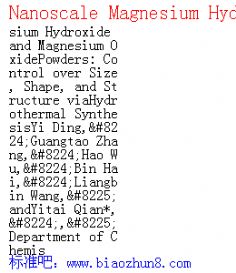Nanoscale Magnesium Hydroxide and Magnesium Oxide
时间:2014-9-3 12:27:28 作者:844799765 来源:Na 阅读:2008次

Powders: Control over Size, Shape, and Structure via
Hydrothermal Synthesis
Yi Ding,†
Guangtao Zhang,†
Hao Wu,†
Bin Hai,†
Liangbin Wang,‡
and
Yitai Qian*,†,‡
Department of Chemistry, and Structure Research Laboratory, University of Science and
Technology of China, Hefei 230026, People’s Republic of China
Received July 25, 2000. Revised Manuscript Received November 1, 2000
Mg(OH)2
nanocrystallines with rod-, tube-, needle-, or lamella-like morphologies have been
synthesized by a hydrothermal reaction using different magnesium precursors and solvents
as the reactants. The products appeared to have narrow size distributions with a monodisperse nature. Subsequent thermal decomposition at 450 °C gave nanosized MgO, which
preserved well the morphological features of the Mg(OH)2 samples. The specific surface areas
of the MgO samples were determined by the BET technique, which gave a feature of high
surface area generally larger than 100 m2
/g. The channels formed in the thermal dehydroxylation process may account for this feature of the MgO nanocrystallines.
1. Introduction
Magnesium oxide (MgO, periclase), as an exceptionally important material for use in catalysis,1,2 toxic
waste remediation3
, or as additives in refractory, paint,
and superconductor products,4-6
has been attracting
both fundamental and application studies.6-10The most
conventional method for synthesis of MgO is the decomposition of various magnesium salts or magnesium
hydroxide (Mg(OH)2, brucite).4,11-13 However, the MgO
products based on this method usually exhibit relatively
large and varied grain sizes, inhomogeneous morphologies, and small surface areas, all of which are disadvantageous for their use in the application field. Therefore, a new and inexpensive method to produce nanosized
MgO with narrow size distribution, controllable structure and morphology, and larger specific surface area
is necessary. One method to prepare nanosized MgO is
the sol-gel technique.14,15 Klabunde et al.16,17 once
prepared ultrahigh surface area Mg(OH)2 and MgO
powders with sizes of about 5 nm via a sol-gel technique followed by a hypercritical drying procedure.
However, the need to synthesize and handle the costly
and hazardous metal-organic precursors in the sol-gel
procedure seems inconvenient and also not economically
acceptable. Recently, we successfully synthesized rodlike and tube-like Mg(OH)2
nanocrystallines through a
very simple hydrothermal technique.18 Further investigations demonstrated that the crystallite size, shape,
and structure of the obtained nanoparticles could be
controlled well by this method, even with the most
commonly used magnesium salts or magnesium powder.
In this paper, we describe an approach for controlling
these characteristics of nanosized Mg(OH)2 through this
hydrothermal route. MgO nanocrystallines from the
thermal decomposition of thus-prepared Mg(OH)2
products were also investigated and we found the obtained
MgO did show a high surface area feature.
2. Experimental Section
The Mg(OH)2
nanocrystalline samples were prepared by the
hydrothermal method using different magnesium sources, such
as Mg powder, MgSO4, and Mg(NO3)
2â6H2
O. All reagents were
analytical grade pure and were purchased from Shanghai
Chemical Co. Ltd. In a typical procedure, 0.01 mol of powder
magnesium sources were added into a Teflon-lined autoclave
* To whom correspondence should be addressed.
†
Department of Chemistry.
‡
Structure Research Laboratory.
(1) Liang, S. H. C.; Gay, I. D. J. Catal. 1986, 101, 293.
(2) Tsuji, H.; Yagi, F.; Hattori, H.; Kita, H. J. Catal. 1994, 148,
759.
(3) Copp, A. N. Am. Ceram. Soc. Bull. 1995, 74, 135.
(4) Bhargava, A.; Alarco, J. A.; Mackinnon, I. D. R.; Page, D.;
Ilyushechkin, A. Mater. Lett. 1998, 34, 133.
(5) Yuan, Y. S.; Wong, M. S.; Wang, S. S. J. Mater. Res. 1996, 11,
8.
(6) Yang, P. D.; Lieber, C. M. Science 1996, 273, 1836.
(7) Wagner, G. W.; Bartram, P. W.; Koper, O.; Klabunde K. J. J.
Phys. Chem. B 1999, 103, 3225.
(8) Boldyrev, A. I.; Simons, J. J. Phys. Chem. 1996, 100, 8023.
(9) Ye, X. S.; Sha, J.; Jiao, Z. K.; Zhang, L. D. Nanostruct. Mater.
1997, 8, 945.
(10) Sterrer, M.; Diwald, O.; Knozinger, E. J. Phys. Chem. B 2000,
104, 3601.
(11) Ardizzone, S.; Bianchi, C. L.; Vercelli, B. Appl. Surf. Sci. 1998,2008

下载说明:
1.请先分享,再下载
2.直接单击下载地址,不要使用“目标另存为”
3.压缩文件请先解压
4.PDF文件,请用PDF专用软件打开查看
5.如果资料不能下载,请联系本站